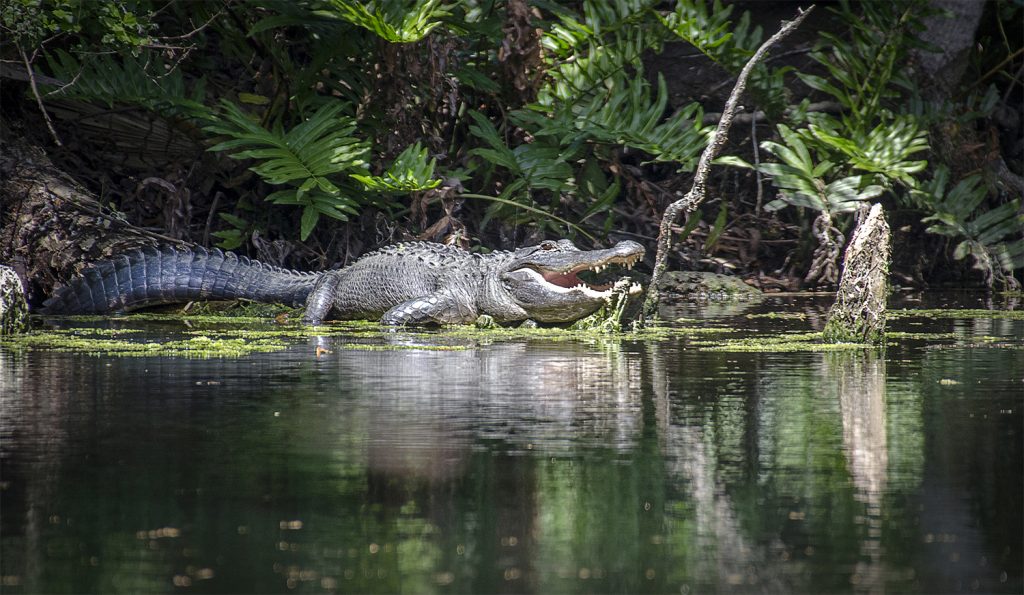
Alligator Mating Season is here!
With the abundance of waterways throughout Florida, there is no doubt about encountering one of these magnificent reptiles at some point while paddling. Many of us are familiar with these creatures and many, perhaps new to our state, or, new to paddling, have little idea about what to expect when paddling in Gator Country during Alligator Mating Season.
The mating season begins in April with the courtship phase and the actual mating taking place in May and June. As a paddler in Florida, it is important to understand alligator behavior and become familiar with safety precautions and several common sense Do’s and Don’ts. This post, using information gathered from the Florida Fish and Wildlife Conservation Commission and over 50 years of personal experience paddling Florida’s waterways, presents information to help ensure a safe paddle while enjoying these Florida natives.
Taxonomy / Classification ~ Habitat & Behavior ~ Breeding Season ~ Warning Signs / Do’s & Don’ts ~ Data & Facts
Taxonomy & Classification
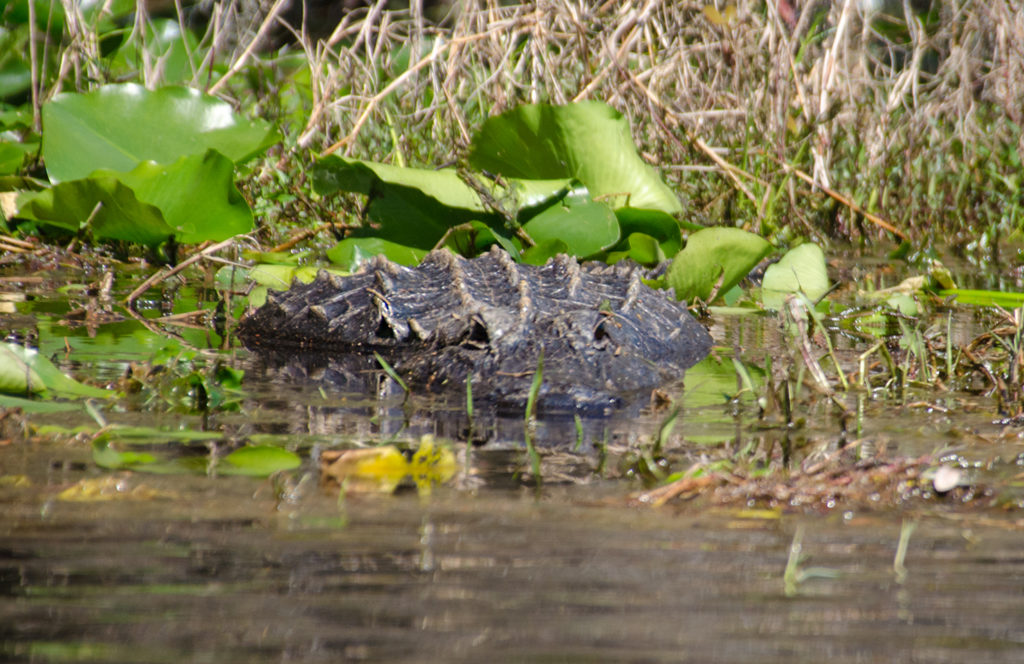
Below is the taxonomy of our Florida Alligators, based on the Integrated Taxonomic Information System…
Kingdom: Animalia
Subkingdom: Bilateria
Infrakingdom: Deuterostomia
Phylum: Chordata
Subphylum: Vertebrata
Infraphylum: Gnathostomata
Superclass: Tetrapoda
Class: Reptilia
Order: Crocodilia
Genus: Alligator
Species: Alligator mississippiensis (Our Florida Alligator}
Legalese – The State of Florida is responsible for the management and control programs related to Alligators. Hunting season is from Aug 15 – Nov 1 each year. Only individuals with proper licenses and permits are allowed to harvest alligators, with two being the limit. Source – Florida Fish and Wildlife Conservation Commission.
Alligator Habitat & Behavior
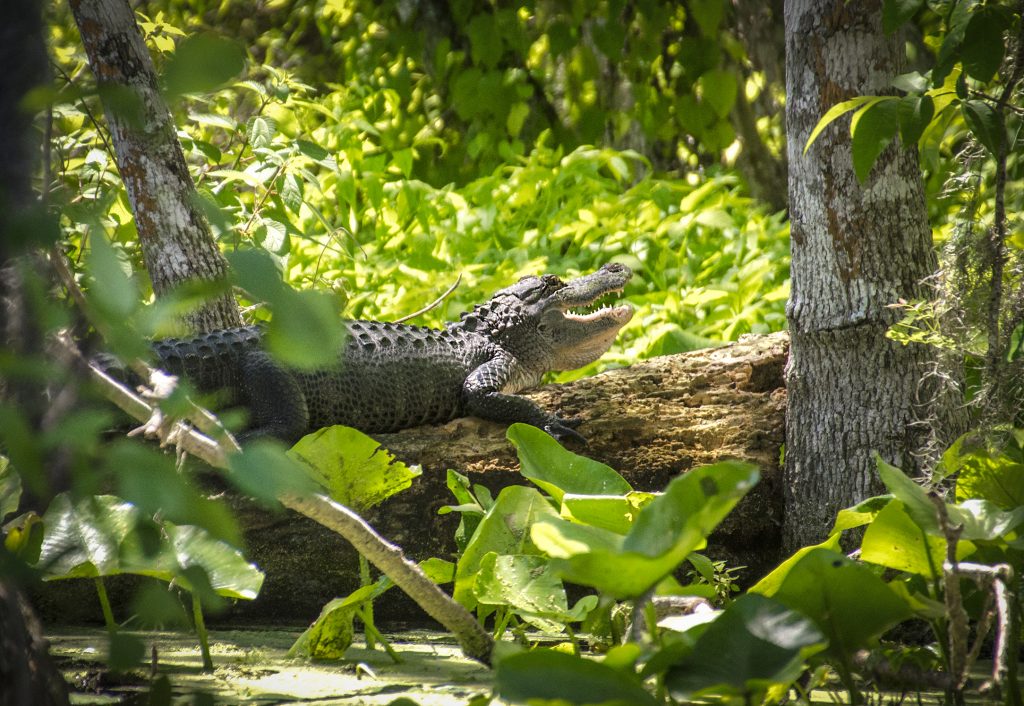
The American Alligator lives in the southern United States, from North Carolina to Texas. These gators can be found in slow-moving rivers, ponds, lakes, and swamps. Gators can tolerate salt water only for brief periods. There’s an old saying in Florida “…if there’s a body of water, there’s probably a gator around.” Despite seeing numerous gators over the years, it is still a special excitement to see one while paddling. Having an understanding of their behavior alleviates many fears, though there were times, I paddled quite briskly when a gator slips into the water and heads my way!
Physical Traits
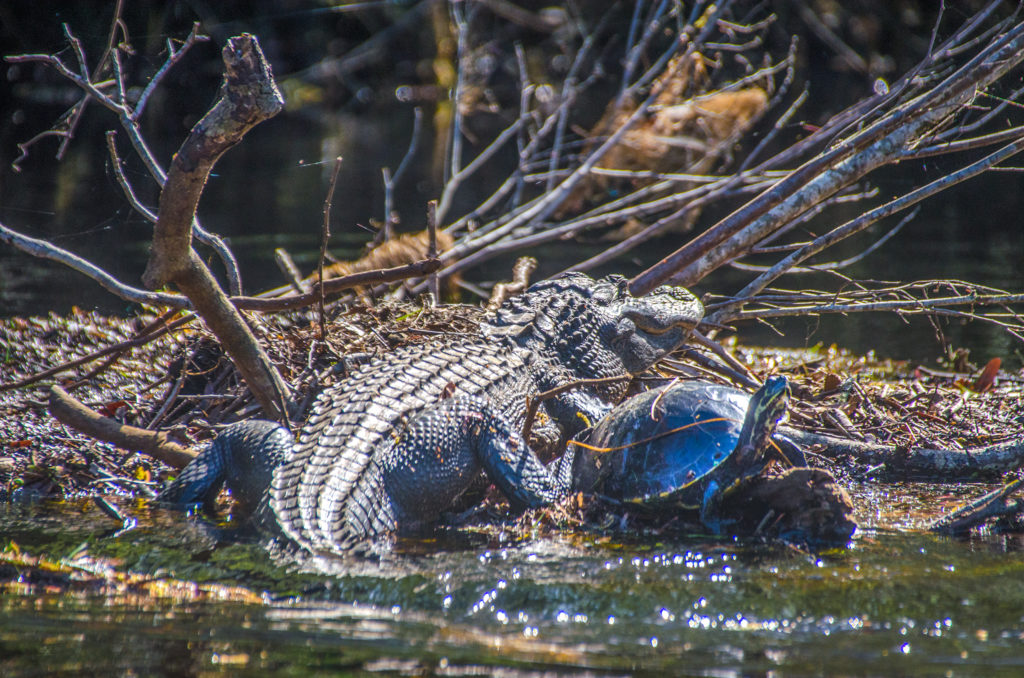
Alligators are best recognized by their familiar scaled or armored body and long tail. Their upward-facing nostrils allow them to breathe while in the water. Adult gators have dark stripes or bands on their tails while younger gators have bright yellow stripes/bands. Male gators can average around 11 feet, while female gators average 8 feet and rarely exceed 10′. The Florida state record for the largest alligator is 14′ 3 1/2″! This was a male gator caught in Brevard County. The record for weight is from my neck of the woods at Orange Lake. A 1,043 lb., 13 ‘ 10 1/2″ male was captured there on April 17, 1989. An alligator’s length can be estimated by converting the distance in inches between the nose to the eye into feet.
Additional Traits
Alligators are social creatures, often found in groups called congregations. These groups are typically seen basking in the sun or swimming.
Because alligators are cold-blooded, they are dependent on external sources of heat to regulate their body temperature. This is accomplished by basking in the sun or moving to areas with warmer or cooler air or water temperatures. They are most active when temperatures are between 82° to 92° F. When temperatures drop below 70° F, alligators stop feeding. They become dormant below 55° F and can be found in ‘dens’, constructed near open water.
Alligators are most active at dusk and at night. During the day they sleep while basking in the sun, however, at night, they are often found near the edges of waterways, hiding in vegetation, camouflaged on logs waiting for unsuspecting prey. They are opportunist feeders and prey on species that are abundant, easily accessible, and easily overpowered.
The diet of adolescent gators consists primarily of small fish, amphibians, and other small invertebrates. Older gators eat larger fish, fowl, turtles, and small mammals. Gators do not chew their food and have to swallow prey whole or, using a strong shaking motion, rip the prey into bite-size pieces. They can swim up to 20 mph and are quite effective hunters in the water.
Alligators are very territorial. Once in the water, they will often stay in the area to protect their territory. They have excellent hearing and are often aware of intruders before they arrive. Gators often slip into the water for their own safety rather than as an aggressive move. If an alligator is hissing it is letting you know you are too close.
Alligators are very protective of their young. Be sure to give young alligators plenty of space and keep an eye out for the mother. You will most likely hear a bellow if you are too close.
Breeding Season
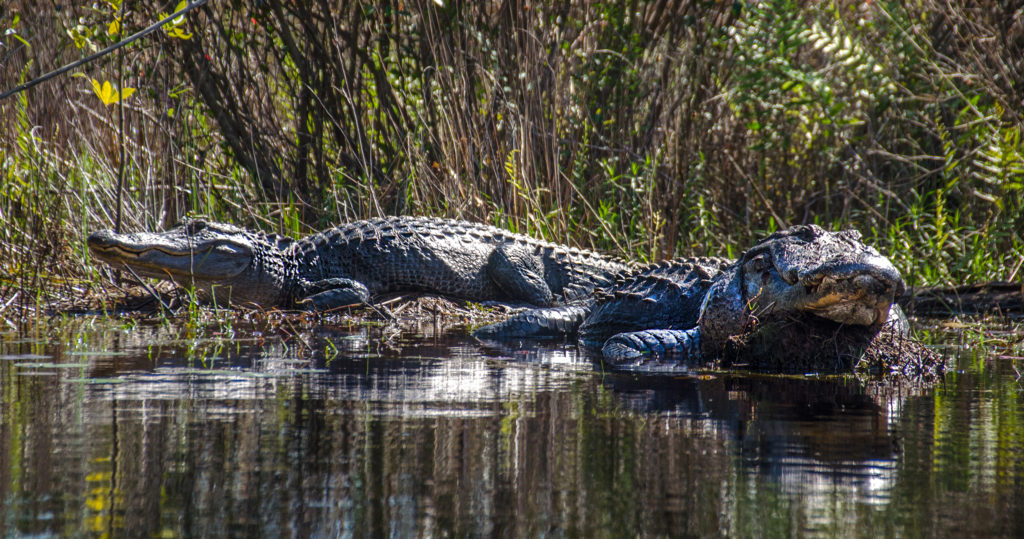
Most alligators reach sexual maturity by the time they are 7 feet in length. This can vary between males and females and can take 10 -15 years for females and 8-12 years for males.
Courtship & Mating
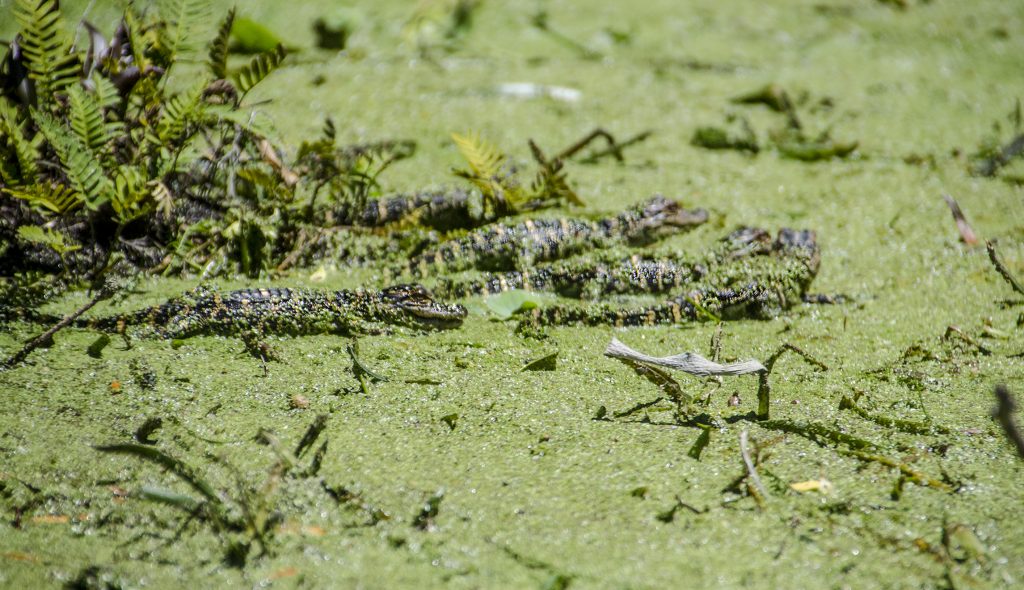
In Florida, courtship usually begins in early April, with mating occurring in May and June. A male may fertilize several females in one season, while the females usually have only one mate each season.
By early July the female alligator begins building a nest from mud, plants, sticks, and other debris and there will lay an average of 32-46 eggs. With incubation taking around 65 days, hatching usually takes place from mid-August to early September. The young hatchlings, around 6 to 8 inches long, will leave the mother after 2 years and be on their own.
Warning Signs
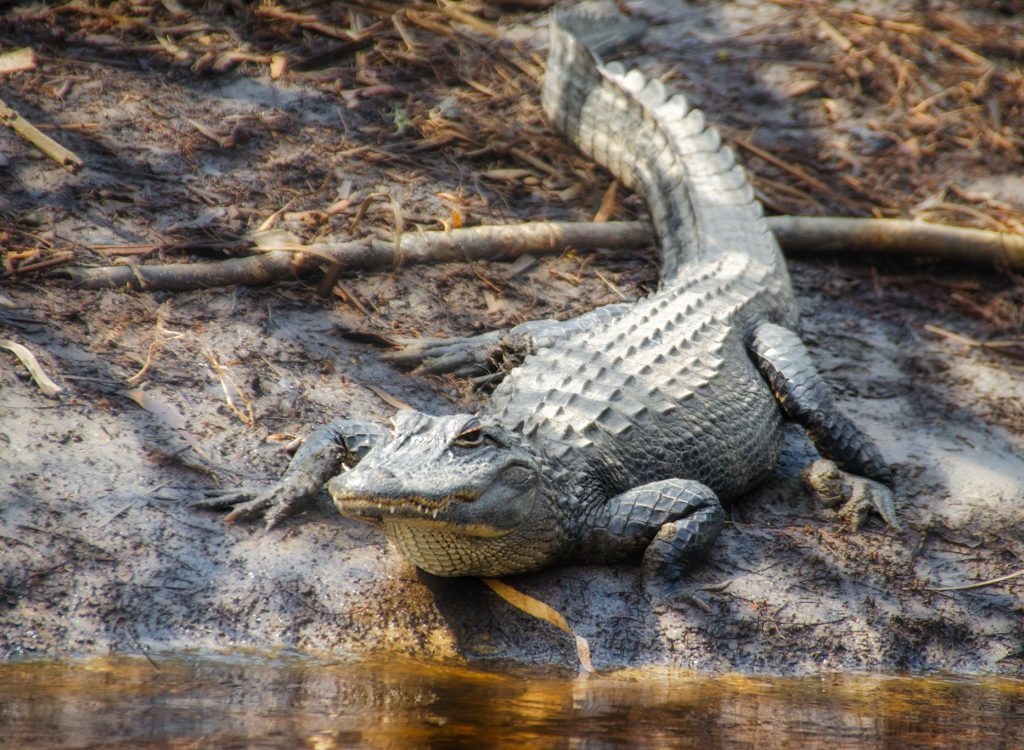
As mentioned earlier, an alligator’s first line of defense is to enter the water. Due to their excellent hearing, they may enter the water long before you approach them. There are those times, however, when a gator will not retreat, especially a female gator, protecting her nest or hatchlings. You will receive the typical warning signs as the gator will face you and with an open mouth begin hissing. It is best to heed this warning and slowly paddle away.
Alligators usually do not approach a paddler, especially in areas where there is not much human traffic, however, if one does approach it is probably because it has been fed by humans before. In this case, it is best to make loud noises to scare them; bang your paddle on the side of your kayak or use something to bang on the bottom of your boat to create noise.
Do’s & Dont’s

Do not feed alligators! Feeding alligators creates a risky scenario by not only drawing a gator too close to your kayak but will also draw the attention of other gators as well. Once gators know humans are a source of food it creates a long-term risk for everybody.
Respect an alligator’s space. A gator, especially during mating season, will definitely let you know you are invading their space. A mother gator will always be ready to defend her hatchlings!
Avoid banks, logs, floating vegetation, overhanging trees, and other areas where an alligator may be camouflaged. Surprising an alligator that’s waiting for prey could trigger an attack.
Be mindful when bringing small pets along with you where alligators are known to congregate!
When fishing from a kayak, land your fish quickly and use a cooler on board to stow your catch instead of using a stringer hanging off the side.
Never assume an alligator is just basking in the sun and a slow creature. It can swim faster than you can paddle.
Be cautious during dawn, dusk, and dark as these are prime times gators are active.
If on a river cleanup, be mindful and aware of your surroundings.
What to do if attacked
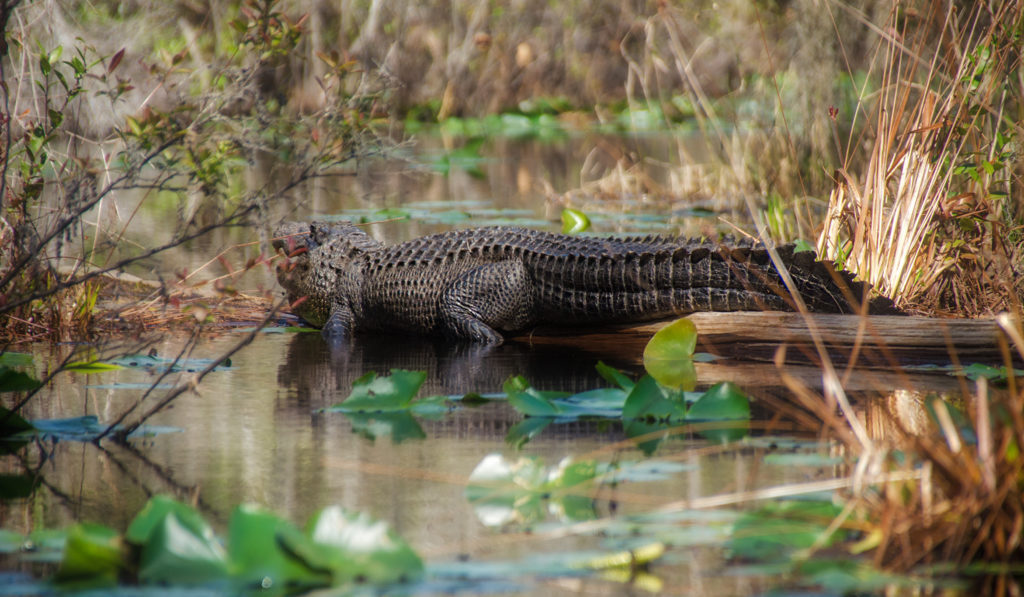
According to Frank Mazziotti, professor of wildlife ecology at the University of Florida’s Fort Lauderdale Research and Education, and Ron Magill, wildlife expert and communications director of the Zoo Miami, there are a few points to try to remember when attacked by an alligator…
Fight Like Hell – If a gator grabs hold of you, there are a few things you can do. Most important, don’t give up.“Fight like hell. Don’t go willingly,” Mazziotti said. “The bigger fight you put up, the more likely it’s going to let you go and say, ‘This isn’t worth it.’
Smack the Snout – “Rather than try to open a gator’s jaws, which are extremely powerful, aim for where the animal is most vulnerable, like its snout.“Pop them on the snout. The tip of their snout is very sensitive. That might be able to get them to release you,” Magill said.
Gouge the Eyes – Jabbing a gator in the eyes may also make it release its bite, even for just a moment, allowing you to get away before it pulls you underwater. “The thing you want to stop them from doing is turning. They’ll grab, and they’ll start rolling to try to break off pieces to eat, and that’s the key thing,” Magill said. “You’ve got to hold on as hard as you can. And the other is to try to poke your fingers in their eyes. That’s easier said than done in that situation, of course, but that’s the best chance you have.”
If bitten, seek immediate medical attention as alligator bites often result in a serious infection.
If you encounter an alligator that is believed to pose a threat to people, pets, or property, call the FWC’s Nuisance Alligator Hotline, toll-free at 1-866-FWC-GATOR (392-4286).
Human Alligator Incidents – https://myfwc.com/media/1776/human-alligatorincidentfactsheet.pdf
Data & Facts
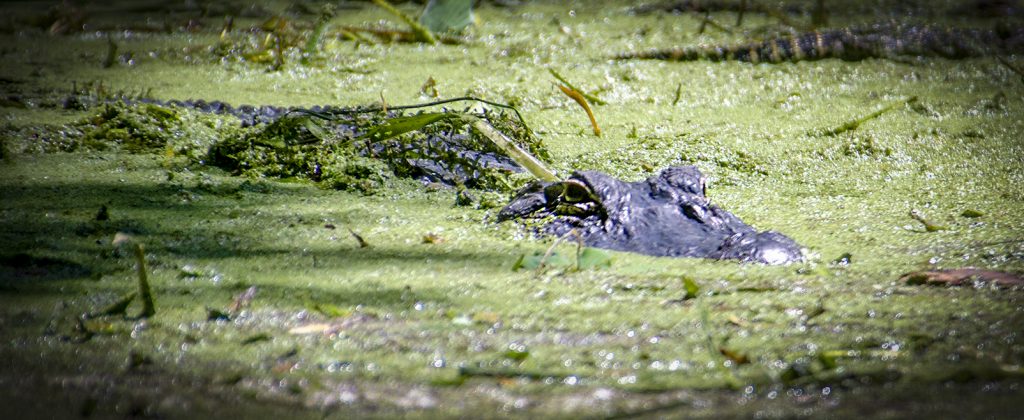
The word “alligator” comes from the Spanish word “el lagarto,” which means “the lizard.”
The American alligator and dinosaurs are cousins. Both alligators and dinosaurs descended from a common ancestor more than 200 million years ago
Though many people are afraid of alligators, these animals keep to themselves and usually don’t attack humans unless they are threatened.
The alligator’s rough skin makes it look like a floating log, which is helpful when stalking prey.
An alligator has five toes on its front feet and four webbed toes on its back feet which help it swim.
An alligator can live for more than 50 years in captivity. The oldest alligator in captivity is over 76 years old and lives in a zoo in Siberia.
There are around 1.2 million alligators in Florida.
The American alligator is the official state reptile of Florida.
An alligator has roughly 80 teeth in its mouth at one time. As the teeth wear down they are replaced with new teeth. An average alligator can go through 2,000 to 3,000 teeth in a lifetime.
There are differences between alligators and crocodiles. Most noticeably, when an alligator’s mouth is closed you cannot see its teeth; when a crocodile’s mouth is closed, the fourth tooth on its lower jaw sticks out.
An alligator can rip and swallow its food, but it cannot chew.
An alligator can stay underwater without air for more than two hours.
Sources
Florida Fish and Wildlife Conservation Commission
Facts About Alligators – By Alina Bradford, Live Science Contributor | October 22, 2014 08:25 pm ET
Florida Alligator Marketing and Education – https://www.florida-alligator.com/General-Information/Alligator-Facts
![]()
